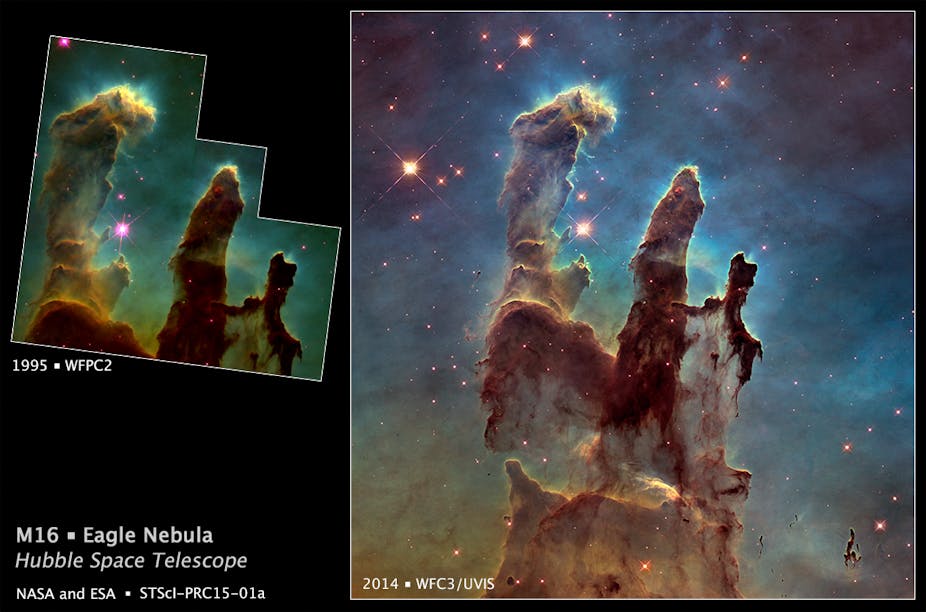It’s the image that back in 1995 saved the Hubble Space Telescope (HST). It turned around five years of public mockery by demonstrating loud and clear that Hubble would live up to – and grow to exceed – the high expectations that had been placed on it.
Dubbed the ‘Pillars of Creation’, this image evokes a response from all people, whether you are into science or not. But one thing scientists want to do is to better understand the pillars and discover what they tell us about the dark, hidden regions where stars form.
This region has been studied in great detail over the last 20 years, and now a new instrument known as the Multi Unit Spectroscopic Explorer (MUSE) on the European Southern Observatory’s Very Large Telescope (VLT) in northern Chile, has provided the means to map the complete structure in three dimensions and determine the orientation of each pillar in space.
The new study, led by PhD student Anna Mc Leod (ESO), was recently published in the journal Monthly Notices of the Royal Astronomical Society.
As part of the study, the authors estimate that these pillars won’t be around for long by cosmic standards. Within three million years they will have completely evaporated away.
That’s provided they are not blown apart by a supernova before then - or perhaps that’s already happened and we’re still waiting for the message to reach us.
One thing’s for certain, star formation is a fascinating and highly captivating process.
The Eagle Nebula
It’s not often realised that the famous pillars of creation are embedded in a beautiful gas cloud known as the Eagle Nebula. The nebula is around 6,500 light-years away and the pillars can be found right in the central region of the cloud. Above and to the right of the pillars is the young star cluster, NGC 6611.

The cluster is around 2 million years old and made up of many bright and massive stars known as O-type and B-type (based on the Harvard Spectral Classification).
These young stars are playing havoc with the gas within the nebula. They shine with intense ultraviolet radiation that ionises or excites the nebula’s hydrogen gas, producing the characteristic red glow of star-forming regions.
The energetic stars also give off strong stellar winds which erodes away at the gas. The pillars of creation consist of dense material that has so far withstood the barrage from NGC 6611.
Beyond visible light
Earlier this year, as part of Hubble’s 25th anniversary celebrations, the pillars of creation were re-imaged by Hubble, capturing the region in visible light and providing a new infrared view as well.
Hubble can observe infrared light at wavelengths slightly longer than visible light. In this light, the pillars almost vanish and it exposes the myriad of stars beyond. Right at the tip of the pillars, brand new stars are beginning to form and it’s these regions that have played a major role in shaping the pillars.

At their tips, the gas is very dense – that’s why we can still see the pillars at these wavelengths – and it has formed a kind of shield.
The stars within NGC 6611 have poured out their intense ultraviolet radiation and blasted their stellar winds into this area. But these three dense pockets of gas have protected the material that lies downwind. Gas on either side has eroded away, leaving only the pillars standing strong.
The European Space Agency’s Herschel Space Observatory has imaged the Eagle Nebula at infrared wavelengths which are longer than what Hubble can detected (what astronomer’s call far-infrared light compared to near-infrared light).

At these wavelengths, Herschel is detecting the glow of cold dust as it re-radiates at just 10 to 40 degrees Kelvin (-263 to -233 degrees Celsius). The pillars are clearly seen and it’s also possible to make out the cavernous hole carved out by NGC 6611 as it heats and ionises its surroundings.
Bring in the MUSE
MUSE is an integral field spectrograph, an amazing piece of technology that combines the power of spectroscopy – or splitting light into its individual wavelengths – with imaging.
It means that for every pixel that makes up an image, a spectrum is also obtained. This is what gives MUSE the ability to map out the pillars of creation in 3D.

Mc Leod and colleagues used MUSE to determine the extinction towards each pillar, or in other words, how much stuff sits between the pillars and us.
The astronomers were able to confirm that the left-most pillar is split into two separate pieces at different distances. The bottom half of the pillar, along with the middle and right-most pillar, are all positioned in front of the star cluster NGC 6611.
However, the top portion of the left-most pillar sits behind the cluster and the tip of that pillar is facing towards us. This is why it appears so much brighter than the other pillars.
Star formation is known to spread from one part of a nebula to another. NGC 6611 represents an earlier episode of star formation, while the dusty pillars are where star formation is happening now (at least as we see it from 6,500 light-years away).
Many fledgling stars have been identified within the pillars over the years. A new result for Mc Leod’s team is the detection of a jet within the tip of the middle pillar that is likely generated by a young protostar, so well hidden that it cannot be detected directly.
Being able to map out how the young massive stars in this nebula influence the birth of new stars is an important step for producing accurate star-formation models - models that help astronomers better understand this complicated process. And while fantastic science is done, we also get to marvel at the beauty of the cosmos.

